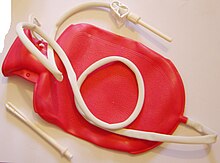Irrigator
In medicine, an irrigator is a liquid container for high enemas (colonic irrigation), vaginal douches and similar applications. By making use of gravity , the fluid can flow from the irrigator into the body cavity with a controlled pressure and an adjustable flow rate.
Application for the vagina
Flushing the vagina after intercourse is not an effective form of contraception . In addition, douching is linked to a number of health problems ( cervical cancer , adnexitis , endometritis, and increased risk of sexually transmitted infections ) and is therefore not recommended.
Women using vaginal douches have also increased predisposition , bacterial vaginosis to develop, which in turn with negative pregnancy consequences (including ectopic pregnancy , low birth weight , premature labor , premature birth and chorioamnionitis is connected) and an increased risk of sexually transmitted infections.
To avoid the transfer of intestinal bacteria into the vagina, the same irrigator must not be used for an enema and a vaginal douche. Ascending urinary tract infections can lead to urinary bladder inflammation , mostly due to contamination with intestinal bacteria.
Form and function
There are cup-like irrigators made of solid material, which are open at the top, and bag-like irrigators made of rubber , which look similar to hot water bottles . The capacity is usually between one and two liters. For use, the irrigator is filled with the prepared temperature-controlled amount of liquid and the hose is attached. Then the irrigator is hung between 30 cm and 1 m above the patient and the stopcock is opened so that the tube is completely filled with liquid and no longer contains any air. The intestinal tube is then inserted into the anus and the stopcock opened so that the liquid flows into the intestine . The speed of influence can be regulated at any time by hanging the irrigator higher or lower.
In addition to the irrigators, which work exclusively by means of gravity, there are also irrigator pumps. These consist of an elastic, manually deformable bottle, a valve system and an intestinal tube. This combination results in a mechanical pump that can be used to easily transport liquid. Manual pressure on the bottle pumps the water into the rectum. The pump can also be activated by gravity by holding the bottle in a higher position. The device has the advantage that the user can control the amount of liquid as well as the temporal course of the enema according to his subjective perception. A non-return valve also prevents rinsing liquid that is contaminated with stool particles from flowing back, so that the bottle is protected from contamination.
Warm water , sometimes chamomile tea, is used as the liquid for the enema . Sometimes healing earth is also added.
See also
literature
- Georg Klemperer : Textbook of internal medicine for doctors and students . August-Hirschwald-Verlag, Berlin 1905, Appendix 2, p. 554 ff. ( Online )
Web links
Individual evidence
- ^ Marian Rengel: Encyclopedia of Birth Control . Oryx Press, Phoenix, Ariz 2000, ISBN 9781573562553 , p. 65.
- ^ BH Cottrell: An updated review of evidence to discourage douching. . In: MCN. The American journal of maternal child nursing . 35, No. 2, March-April 2010, pp. 102-107; quiz 108-9. doi : 10.1097 / NMC.0b013e3181cae9da . PMID 20215951 .
- ^ Moises Velasquez-Manoff: What's in Your Vagina? A healthy microbiome, hopefully. . In: Slate . January 11, 2013.
- ^ BH Cottrell: An Updated Review of Evidence to Discourage Douching . In: MCN, the American Journal of Maternal / Child Nursing . 35, No. 2, 2010, pp. 102-107; quiz 107-9. doi : 10.1097 / NMC.0b013e3181cae9da . PMID 20215951 .

